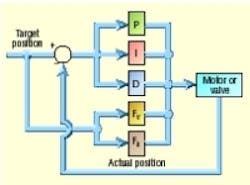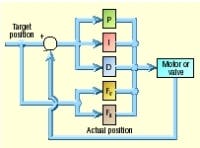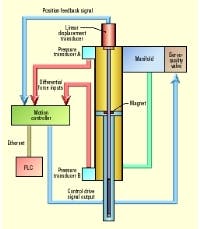On/off or closed-loop control?
Deciding whether to use discrete (on/off) control or closed-loop control requires consideration of several factors. In actuality, the choice between discrete control (sometimes called bang-bang control because of the noise that an actuator makes when it stops abruptly) and closed-loop control is not an "apples-to-apples" comparison because discrete control only specifies the output, whereas closed-loop (servo) control implies continuous feedback and continuous output control.
Factors to consider
You can use discrete valves with no feedback, with discrete limit switches, or photo eyes to provide coarse position information. Discrete valves can also be used with continuous position or velocity feedback. Continuous feedback can come from an analog feedback device, an encoder, or a linear displacement transducer (LDT). Even if you are using a proportional or servovalve, using only open-loop control with the same feedback options as with a discrete valve will suffice for many applications. Finally, high-end systems use an encoder or LDT for feedback, closing the loop with a servovalve or servo-quality proportional valve.
The available choices can be arranged with the feedback options on one axis and the control options on another (see table). Two combinations in the table do not apply because closed-loop control cannot be accomplished without continuous feedback — limit switches or photo eyes are not enough.
Feedback options
Obviously, the least expensive feedback method is to use none at all. This no-feedback control often is augmented by human operators that close the loop using their vision, reflexes, and hand-eye coordination. For automation, this method provides limited flexibility because the only positions that can be achieved with certainty are when the cylinder is fully extended or retracted. The actuator will also travel at varying speeds depending on changes in load, pressure, and even how warm the fluid is. However, this method is adequate for many applications.
| Feedback and control combinations | |||
| Control type | |||
| Feedback | On-off | Open-loop servo | Closed-loop-servo |
| None | Least precise | Limited speed control | |
| Discrete | Stop at position | Stop at position with ramping | |
| Continuous | Flexible stop at position | Ramp to position | Precise control |
Discrete feedback (limit switches and photo eyes) is the next step up. This option uses either discrete valves or proportional valves to drive the hydraulics. Although it is possible to hard-wire limit switches and photo eyes directly to the valves or use mechanical relays, the tradeoff is a very inflexible system. Changing the wiring can be expensive, and the locations where the limit switches and photo eyes can be mounted may change with different manufacturing needs. Also, it can be difficult to mount limit switches and photo eyes where they need to be. Therefore, to provide the needed flexibility, computers or programmable controllers normally are placed between the detectors and the valves. Because of this, a large cost that isn't immediately obvious — but which must be considered — is the cost of programming.
The most flexible form of feedback is one that provides continuous position feedback. Magnetostrictive LDTs mounted inside or alongside cylinders provide excellent position feedback. With continuous feedback, velocity can be determined by detecting how fast position changes. This information is critical in applications where motion must be accurate and repeatable.
Output control options
Open-loop control with on/off valves — Using discrete valves is the simplest, but most limited way to control hydraulic flow. The ability to control or synchronize motion is difficult. However, you can use multiple discrete valves for a rough control of speed.
For years, systems have used high-and low-flow valves mounted in parallel. Decreasing the flow rate of oil to decrease the speed of an actuator required shutting off the high-flow valve as the actuator approached the set point. This left the low-flow valve on, causing the actuator to creep close to the set point when it, too, was shut off.
This high-speed/low-speed valve approach achieves relatively good accuracy with little complication except for the feedback device. On/off valves can be used with limit switches or continuous feedback devices depending on the requirements.
Open-loop control with proportional valves — Accuracy and throughput can be improved by replacing high-and low-speed discrete valves with a proportional valve. Even simple systems can run in open loop until a ramping zone is reached. This occurs when the actuator nears a target set point, so output tapers down as a function of the distance remaining. This is not strictly closed-loop control because the error (the distance between actual and target positions) is not being used as feedback. However, it can be an effective means of control if loads are relatively constant.
Proportional or servovalves can be used in either open-or closedloop mode. Open-loop control sometimes is all that is required — for example, if a process is repeatable enough, you can be fairly sure a given output will result in a desired speed. This is easy to implement because you can use a simpler controller or PLC with an analog output.
An analog output from the PLC or computer ranging from 10 to +10 V can cause a valve spool to shift continuously as the voltage to the valve's solenoid changes. This allows rough control of the flow and, therefore, the speed — as long as variables such as the pressure across the valve and the load remain constant.
A slightly more sophisticated variation is to use feedback not to close the loop, but to change the output as a function of distance. Ramping of the control output as a function of distance is usually accomplished using a PLC or a basic motion controller. This form of control works well in applications where accuracy is not as important as simply ramping down the output to accomplish smooth speed reduction. Generally, no precise tuning of the motion is required in these systems.
Closed-loop control
The main reasons for using closed-loop control are flexibility, accuracy, speed, and the ability to maintain precision with changing conditions (loads). As productivity demands increase, more and more applications and processes require
more sophisticated closed-loop controllers.
At the high end of control is a combination of continuous feedback and closed-loop control. Closed-loop control compares the feedback position from the feedback device to a desired position.
This error is multiplied by a proportional gain — a ratio that converts the error in position units to output in volts or milliamps. The greater the error, the higher the output must be to correct the error. Higher-end controllers augment the proportional (P) gain with integral (I) and differential (D) gains. Figure 1 shows how the gain factors combine to implement precise closed-loop control.
Higher end controllers can also augment proportional gain with feedforwards, which are really just open-loop gains used as predictive factors in combination with closedloop control. For example, if you know the actuator will move at 2 in./sec-V, then 4 V should be applied to go 8 in./sec. Of course, this assumes that hydraulics respond in a linear manner, which they don't. However, if the feedforward term provides an output that approximates the desired value, then the PID terms can correct for any non-linearity or changes in load not predicted by the estimate. Without feedforward terms, the PID terms would have to compensate for a larger error, resulting in an increased likelihood of system lags and instability.
The combination of PID, feedforwards, continuous feedback, and a servovalve or servo-quality proportional valve allows the controller to go to positions using velocities, accelerations, and decelerations that the user can program. The programmable accelerations and decelerations reduce the wear and tear on the hydraulics and mechanical system.
For example, with presses, you can ramp down the velocity so that when the tooling hits the work piece, the press will have just the right amount of kinetic energy to do the necessary work. Figure 2 shows a system diagram of the hydraulics used in a highend press, with position feedback provided by a magnetostrictive LDT and differential pressure (force) feedback provided by two pressure sensors mounted in the cylinder. Control is provided via a proportional servovalve.
Sometimes a combination of open loop and closed loop is best. For instance, many single-axis presses do not need precise control until the tooling gets close the work piece. In this case, the actuator can be commanded to move down at a high speed using openloop control. Once the actuator gets close to contacting the material, control can be switched to closed-loop position control. Upon contact with the material, a logical decision can be made to seamlessly transition from closed-loop position control to closed-loop pressure or force control by using pressure feedback sensors.
Communications
A good controller should have good networking support in order to fully take advantage of its control capabilities. It makes no sense for a controller to be able to change set points on the fly if these set points can't be updated from some external source quickly and easily. Also, a closed-loop motion controller is not very flexible if it has only a handful of inputs that can tell it to go to only a small number of pre-programmed positions. More-advanced controllers have Ethernet, PROFIbus, or other fieldbus networks that make interfacing to other devices easier.
This allows parts manufacturing machines to take advantage of the flexibility of the controller so new set points can be down-loaded when making new part types. In some cases, new set points can be downloadedfor each unique workpiece.
Another valuable advantage of motion controllers with fast communications is diagnostics. The best can graph the desired and actual motion profiles. This greatly eases tuning and troubleshooting of the entire motion system.
Choosing between closed-loop and open-loop control ultimately depends on the requirements of the specific application. In some cases, using continuous feedback and proportional valves with open-loop control may be reasonable answer. Whichever route you choose, go with an appropriate motion controller that can be optimized for hydraulic motion control.
For more information, contact the author at [email protected] or visit www.deltamotion.coms



